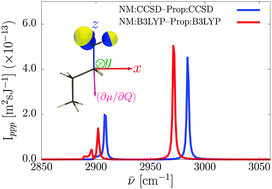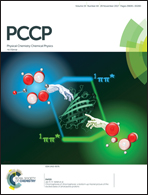Coupled-cluster sum-frequency generation nonlinear susceptibilities of methyl (CH3) and methylene (CH2) groups†
Abstract
The first vibrational sum frequency generation (SFG) spectra based on molecular properties calculated at the coupled cluster singles and doubles (CCSD) level of approximation have been simulated for interfacial model alkyl chains, providing benchmark data for comparisons with approximate methods, including density functional theory (DFT). The approach proceeds in three steps. In the first two steps, the molecular spectral properties are determined: the vibrational normal modes and frequencies and then the derivatives of the dipole moment  and of the polarizability
and of the polarizability  with respect to the normal coordinates. These derivatives are evaluated with a numerical differentiation approach, of which the accuracy was monitored using Romberg's procedure. Then, in the last step, a three-layer model is employed to evaluate the macroscopic second-order nonlinear optical responses and thereby the simulated SFG spectra of the alkyl interface. Results emphasize the following facts: (i) the dipole and polarizability derivatives calculated at the DFT level with the B3LYP exchange–correlation functional can differ, with respect to CCSD, by as much as ±10 to 20% and ±20 to 50% for the CH3 and CH2 vibrations, respectively; (ii) these differences are enhanced when considering the SFG intensities as well as their variations as a function of the experimental configuration (ppp versus ssp) and as a function of the tilt and rotation angles, defining the orientation of the alkyl chain at the interface; (iii) these differences originate from both the vibrational normal coordinates and the Cartesian derivatives of the dipole moment and polarizability; (iv) freezing the successive fragments of the alkyl chain strongly modifies the SFG spectrum and enables highlighting the delocalization effects between the terminal CH3 group and its neighboring CH2 units; and finally (v) going from the free chain to the free methyl model, and further to C3v constraints on
with respect to the normal coordinates. These derivatives are evaluated with a numerical differentiation approach, of which the accuracy was monitored using Romberg's procedure. Then, in the last step, a three-layer model is employed to evaluate the macroscopic second-order nonlinear optical responses and thereby the simulated SFG spectra of the alkyl interface. Results emphasize the following facts: (i) the dipole and polarizability derivatives calculated at the DFT level with the B3LYP exchange–correlation functional can differ, with respect to CCSD, by as much as ±10 to 20% and ±20 to 50% for the CH3 and CH2 vibrations, respectively; (ii) these differences are enhanced when considering the SFG intensities as well as their variations as a function of the experimental configuration (ppp versus ssp) and as a function of the tilt and rotation angles, defining the orientation of the alkyl chain at the interface; (iii) these differences originate from both the vibrational normal coordinates and the Cartesian derivatives of the dipole moment and polarizability; (iv) freezing the successive fragments of the alkyl chain strongly modifies the SFG spectrum and enables highlighting the delocalization effects between the terminal CH3 group and its neighboring CH2 units; and finally (v) going from the free chain to the free methyl model, and further to C3v constraints on  leads to large variations of two ratios that are frequently used to probe the molecular orientation at the interface, the (r−a + r−b)/r+ ratio for both antisymmetric and symmetric CH3 vibrations and the Ippp/Issp ratio.
leads to large variations of two ratios that are frequently used to probe the molecular orientation at the interface, the (r−a + r−b)/r+ ratio for both antisymmetric and symmetric CH3 vibrations and the Ippp/Issp ratio.

- This article is part of the themed collection: 2017 PCCP HOT Articles


 Please wait while we load your content...
Please wait while we load your content...